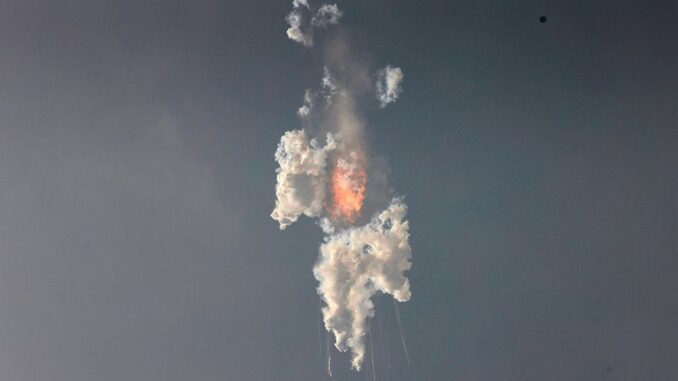
Estimated reading time: 12 minutes
Space Exploration Technologies Corporation, better known as SpaceX, the world’s largest privately owned manufacturer of spacecraft, has failed yet another launch, and spectacularly blown up yet another of its rockets. The first test launch of SpaceX’s “Starship” model was conducted in southern Texas, near the border with Mexico, on Thursday. Space exploration enthusiasts gathered to watch as the would-be spacecraft lifted off the launch pad, soared several miles up into the atmosphere, and then, malfunctioning, exploded over the Gulf of Mexico.
SpaceX’s public relations team have tried to diminish the company’s failure with almost unbelievable euphemisms. “Starship experienced a rapid unscheduled disassembly before stage separation,” read one SpaceX tweet, referring to the explosion. The company went on to congratulate itself on an “exciting” test. These statements, which accord with the company’s “Fail fast, but learn faster” motto, have been widely mocked by Twitter users, racking up thousands of replies and quote-tweets.
SpaceX has indeed failed — but it has “learned” at a much slower rate than Elon Musk, the company’s world-famous owner, would like to admit, and with exorbitant costs.
Back in 2016, Musk first began pitching the biggest, most powerful spacecraft of all time — a spacecraft capable of fulfilling Musk’s bizarre, painfully unrealistic, and ultimately doomed fantasy of someday ruling over the first human colonies on Mars — which he christened the Mars Colonial Transporter. At that year’s International Astronautical Congress in Guadalajara, Mexico, Musk unveiled rough schematics for the more sensibly renamed Interplanetary Transport System (ITS), and promised that SpaceX was already working on it. The SpaceX ITS was presented as having the capacity to transport as many as one-hundred settlers to Mars. By 2022, Musk promised, the first ITS mission to Mars, carrying colony-starting cargo, would launch; a follow-up mission, carrying the first human Martians, would then launch in 2024.
Needless to say, SpaceX failed to deliver, and Musk’s interplanetary colonization fantasy remains just that — a billionaire con-artist’s fantasy.
Soon thereafter, in 2017, Musk revised the ITS down to about three-quarters of its initially promised size, and renamed it again to an unexplained “BFR.” The project’s purpose was also revised: Instead of far-flung fantasies of colonizing Mars, the BFR would be used, like most spacecraft are, for launching satellites into Earth’s orbit. Finally, BFR was renamed to Starship, and a new, still simpler model was released.
Musk’s fans and investors were disappointed, but to keep them from becoming altogether disenchanted with his long-con, he promised in 2019 that the first unmanned Starship test launch would be conducted within six months, and that the first manned Starship flight would follow in 2020. Those due dates passed by without a word, but Musk made similar promises over the next few years. In 2022, for instance, he announced on Twitter that the first Starship would be conducted later that year. But the remainder of 2022, as we know, also passed by without a word about the new spacecraft.
Finally, as of April 2023, the wait is over. But the “payoff” for everyone’s anticipation was, rather than a successful unmanned flight, a spectacular explosion — or, if you will, a “rapid unscheduled disassembly.”
According to statements from Musk, Starship development alone has cost SpaceX as much as $10 billion since the ill-fated Mars Colonial Transporter was first announced. Despite failing to show any return on investment since then, and despite repeated delays, false promises, and failures, Musk and his capitalist cohorts have profited. Why? Because, as it happens, the billionaires aren’t playing with their own money — they’re playing with ours. SpaceX receives most of its corporate income from lucrative, taxpayer-funded government contracts, especially with NASA, or else from other Federal Government-contracted firms like DARPA, and stands to lose nothing if and when it fails to deliver on its end of the bargain. Our capitalist-serving rulers in Congress are more than happy to keep those contracts coming. That’s why an unscrupulous con-artist like Elon Musk can proffer years upon years of empty and downright delusional promises, but still rake in billions of dollars in personal profits.
Musk’s failures at SpaceX mirror his more recent blunders as the newest owner and CEO of Twitter. In 2022, Musk offered to buy Twitter, entered and completed negotiations, and then attempted to back out, before being compelled by a lawsuit to complete the $44 billion acquisition.
The social media company has been deteriorating ever since. The platform has suffered continual technical disruptions as Musk has insisted on “streamlining” basic Twitter features, and complaints from Twitter users of an increasingly broken website and app have become ubiquitous in recent months; not long ago, some tech experts believed that the platform might suddenly and irreparably collapse. Musk has also laid off hundreds of Twitter employees — over half of the “veteran” staff — over what amounted to personal grudges and ego-tripping, effectively depriving the platform of the skilled labor that built it, and shooting himself in the foot.
Musk, who identifies, to no one’s surprise, as a conservative Republican, has also reneged on pledges to make “free speech” on Twitter absolute — to make the platform what he pretentiously called a “digital town square.” Instead, the new Twitter CEO has instituted wide-ranging censorship against pro-LGBT activist networks, Palestinian journalists, his own critics, and other voices that run even remotely counter to his reactionary politics, while at the same time promoting fascist conspiracy theories.
This combination of technical incompetence, instability, and noxious politics has driven away advertisers, as most brands increasingly tend to avoid association with hate speech that stands to alienate large portions of their consumer bases.
The result? As of late March, only about five months after he was forced to purchase Twitter in October 2022, Musk admitted that Twitter’s total value has plummeted by more than half, from the $44 billion Musk found himself legally obligated to pay to around $20 billion. In other words, Musk’s impulsiveness lost him around $24 billion within five months — and those are just the losses he’s incurred in his Twitter misadventure.
As Twitter implodes, Musk’s electric vehicle manufacturer, Tesla, is reeling from two years of financial decline.
A coalition of Tesla’s capitalist shareholders, fearing that Musk’s repeated failures, public embarrassments, and long-term mismanagement of SpaceX and Twitter will hurt the firm’s public image, and thus their own profits; they are calling for the company’s board to “rein in” Musk. Tesla’s Q1 net income has dropped by 24% relative to last year, despite Musk’s failed tactics of repeatedly slashing prices on Tesla vehicles in the U.S., China, and other markets in the hope of attracting new buyers. The firm’s stock prices are falling, and some capitalist economists expect it to “crash” soon.
In the aftermath of a dismal 2023 Q1 investor report, released Thursday, and another embarrassing SpaceX explosion, concurrently, Tesla shares fell by nearly 10%, dropping Musk’s personal wealth by nearly $13 billion overnight.
Tesla’s image has also been marred by a workers’ rights scandal involving racist abuse. The firm has lost the second of two civil trials in which the plaintiff, Owen Diaz, a Black former employee, sued Tesla for nearly $160 million in punitive damages, after suffering years of racist hate crimes from managers and fellow employees in his workplace. The court has awarded Diaz a mere $3 million — a “slap on the wrist” for the giant firm.
In sum, Musk, like most billionaires who swell daddy’s fortune into a bigger fortune, is at heart a con-artist, in practice a bungling clown, and in principle a parasite. Musk’s fortune has swelled only for the same reason that the abdomen of a mosquito swells when, by its good fortune, it finds an opportune victim, and it will just as readily burst.
What is really unfortunate about this parasitic circumstance is how wasteful it is, how much it impedes scientific and technological progress.
Musk brags that SpaceX’s Starship model is the most powerful rocket ever built — although evidently not powerful enough to make it out of the atmosphere, putting it categorically behind Cold War-era technology.
Instead, the really alluring prospect of the SpaceX Starship model is its (yet to be proven) reusability. All existing spacecraft are good for only one use, because they are severely damaged upon reentry from space, due to the friction and heat generated by any object that plummets through Earth’s atmosphere, and from impacting Earth’s oceans; it is cheaper for space agencies to simply build a new rocket, rather than to repair one that’s completed a journey. A reusable spacecraft would reduce the cost of a launch from a few billion U.S. dollars (the cost of building a brand new spacecraft) to several million (the cost of transport, rocket fuel, and other secondary costs alone), which could fundamentally change the economy of space exploration.
Unfortunately, these great technological prospects have been left not in the capable hands of the world’s foremost experts, enjoying the full backing of public confidence, but in the bungling hands of one man who happened to inherit a fortune. Musk was born in Pretoria, South Africa, in 1971, under that country’s apartheid regime. His father, Errol Musk, is a capitalist politician in South Africa who owned shares in a Zambian emerald mine that hyper-exploited colonial labor — information that Musk is now aggressively trying to remove from the public consciousness. And yet Musk presents himself not only as a self-made billionaire, but also as a self-made rocket science expert, despite admitting that his knowledge on the subject amounts to a handful of textbooks he claims to have read and some rambling phone conversations with actual scientists several years ago. Musk’s “supergenius billionaire” facade has been further cultivated by his frequent appearances on talk shows, where sycophantic talking heads gush over his every word, his online cult in spaces like Reddit, populated by easily duped liberal technocrats, and his occasional cameos in superhero, spy, and sci-fi movies, series, and franchises, such as the Marvel Cinematic Universe.
In truth, however, spacecraft are built by highly educated, extensively credentialed, professionally trained engineers, who have dedicated their lives to their field — not by clueless-amateur billionaires playing at an “eccentric boy-genius” persona. Just like his billionaire fortune, Musk’s charade of expertise, and his entirely fictitious claim to “scientific” fame, is more a product of the circumstances of his birth, the fact that he “walked the streets of New York with emeralds in his pocket” as a teenager, than of any scientific merit or accomplishment.
Anyone can see that entrusting so much potential for technological progress to one clownish billionaire, or even to a corporate board of billionaires, is a bad idea. (Hence this real-world situation is the set-up for myriad dystopian fictions.) The problem is that, in a society dominated by the capitalist mode of production, the sciences and technology cannot advance otherwise than for the profit of enormous profiteering firms, owned in the main by a relatively small class of opulent monopoly-capitalist oligarchs. These firms have concentrated the vast majority of productive property, including the means of scientific production, in their corporate hands, and the result is that science itself is at the mercy of our capitalist overlords.
Wealth is built not by the supposed “genius” of the few capitalists, but by the labor of the many, by the workers they employ. Science is no different: The scientific knowledge and technological innovations expropriated by capitalist firms as their own, with a regime of patents, trademarks, and paywalls, were toiled over with the brains and hands of the many scientists — science workers — and engineers forced to subjugate their expertise to serve the profit-motive of their capitalist employers.
Only by overthrowing and abolishing the dictatorship of the capitalist parasites, and only by abolishing their irrational, anarchic mode of production, can science be liberated, and be repurposed to serve a liberated populace.

